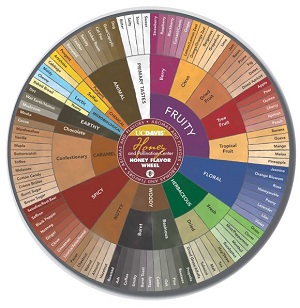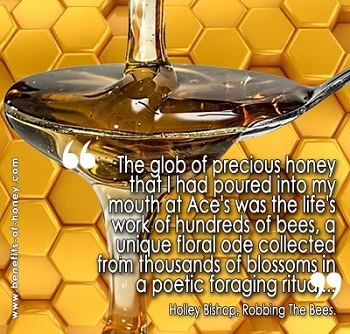
100 Interesting Ways to Describe the Taste of Honey
How much could you relate to this description for honey? - "Dark amber… it has hints of the woody forest with an underlying resinous taste but finishes warm and spicy."
Hardly, if you think "Honey is honey, it's sweet and just that simple!"
"Taste of Place"
Honey is not just about its pollen and nutrition value. Honey connoisseurs love to muse about its color, flavor, depth, the swirl, the aroma, the taste and the finish, just like wines. The age-old concept of Goût de Terroir, which means "Taste of Place" in French, can be justifiably applied to honey for the same reasons. The word terroir is associated with fine wines - the soil, climate and the geographic region are responsible for the unique characteristics of each wine. Terroir determines where the plant will grow, when it will blossom, how much nectar it will produce and the bees' ability to forage. The complexity and diversity of honey is thus a result of the floral sources that the bees visit, the area's weather and climatic conditions, its geographical location and other variable factors. As Stephanie Rosenbaum of Honey: From Flower to Table expresses it so beautifully,
"Veiled in this fragile filigree of wax is the essence of sunshine, golden and limpid, tasting of grassy meadows, mountain wildflowers, lavishly blooming orange trees, or scrubby desert weeds. Honey, even more than wine, is a reflection of place. If the process of grape to glass is alchemy, then the trail from blossom to bottle is one of reflection. The nectar collected by the bee is the spirit and sap of the plant, its sweetest juice. Honey is the flower transmuted, its scent and beauty transformed into aroma and taste."
~ Stephanie Rosenbaum

Honey Descriptors
Now there is even an elaborate Honey Flavor Wheel (2014) invented by the Honey and Pollinator Center at the Robert Mondavi Institute that offers tasters a way to describe honey an describes the flavors and nuances of honey with references to almost 100 interesting descriptors that include hay/straw, tea, cheesy, butterscotch, confectionary, cotton candy, burnt sugar, burnt toast, dirt, baked bread, and even unsavory labels such as barnyard, dog and cat pee. Before you question or doubt the credibility of the Honey Flavor Wheel, it is reported that the production actually involved six months of research and development that brought together a group of 20 trained tasters, beekeepers, food enthusiasts and a sensory scientist. When tasting honey, with this huge lexicon to the tastes and aromas, it is no longer acceptable to say "it's sweet"!

Growth of Honey Usage
Honey has grown exponentially in its use with chefs, manufacturers and consumers over the years, especially with cakes and pastries. With consumers' preferences leaning towards natural and artisanal, honey has a huge potential as a premier ingredient in foods and beverages. Food producers are recognising the fantastic versatility of honey in combining with other foods, transforming flavor profiles and adding depth of character. Besides taste, honey has many functional benefits for both cooking and baking. It attracts and holds moisture, enhancing freshness and shelf life, and it acts as a binder and thickener for sauces, dressings and marinades. Honey also adds a rich golden or amber finish to recipes.
Related Pages
1. Hate the taste of honey? Don't give up, because there are too many floral varieties of honey to choose from: Taste Honey? No Way!
2. This honey has been described as one that you would either swear by it or swear about it: An Irreplaceable Tasmanian Honey
3. Tips on how to taste honey like a pro: Appreciate the Taste of Honey Varieties Like a Pro
4. The endless floral varietals of honey: Exploring 36 Honey Floral Varieties (#21 is Highly Sought-After)